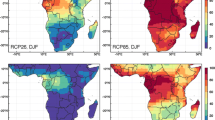Abstract
In recent years there have been several spells of high temperatures providing analogues for the conditions that might become more common as a result of the enhanced greenhouse effect. Statistical models were developed of the relationship between the monthly incidence of food poisoning and temperatures and these were then used to provide estimates of the possible effects of future warmer summers. Routinely collected data on the number of reported cases of food poisoning were analysed for the years 1982–1991. Regression analysis was used to establish the relationship between the monthly incidence of food poisoning and temperatures of the same and the previous month. Published scenarios for future temperatures were applied to these statistical models to provide estimates of the possible impacts of warmer conditions. The monthly incidence of food poisoning was found to be significantly associated with the temperature of the same and of the previous month with the latter having the stronger effect. Using published data on the relationship between reported and actual numbers of cases of food poisoning, it is estimated that annually there might be an additional 179 000 cases of food poisoning by the year 2050 as a result of climate change. The observed relationship with the same month's temperature underlines the need for improvements in storage, preparation and hygiene close to the point of consumption. However, there was a much stronger relationship with the temperature of the previous month, indicating the importance of conditions earlier in the food production process. Improvements in areas such as animal husbandry and slaughtering may also be necessary to avoid the adverse effects of a warmer climate.
Similar content being viewed by others
References
Central Statistical Office (1982–91) Monthly digest of statistics. HMSO, London
Chambers JM, Hastie TJ (1992) Statistical models in S. Wadsworth and Brooks, Pacific Grove, California
Chief Medical Officer (1990) On the state of the public health for the year 1989. HMSO, London
Hobbs BC, Roberts D (1987) Food poisoning and food hygiene. Edward Arnold, London
House of Commons Agriculture Committee (1989) First report on salmonella in eggs. HMSO, London
Johnston AM (1990) Veterinary sources of foodborne illness. Lancet 336:856–859
Jones K, Almond S (1992) Moving out of the linear rut: the possibilities of generalized additive models. Trans Inst Br Geogr New Ser 17:434–447
Langford IH, Bentham G (1993) The potential impacts of climate change on winter mortality in England and Wales. CSERGE Working Paper GEC 93-25, University of East Anglia, UK
Lund BM (1990) Foodborne illness due toBacillus andClostridium species. Lancet 336:982–986
North R, Gorman T (1990) Chickengate: an independent investigation of the salmonella in eggs scare. Institute of Economic Affairs, London, UK
Office of Population Censuses and Surveys (1982–91) Communicable disease statistics: Series MB12. HMSO, London
Richmond M (1990) The microbiological safety of food. Part 1. Report of the committee on the microbiological safety of food. HMSO, London
Roberts D (1986) Factors contributing to outbreaks of foodborne infection and intoxication in England and Wales 1970–82. Proceedings of the 2nd World Congress of Foodborne Infections and Intoxications. Institute of Veterinary Medicine, Berlin
Roberts D (1990) Sources of infection: food. Lancet 336:859–861
Roberts JA, Sockett PN, Gill ON (1989) Economic impact of a nationwide outbreak of salmonellosis: cost benefit of early intervention. Br Med J 298:1227–1230
Todd E (1990) Epidemiology of foodborne illness: North America. Lancet 336:788–790
Warwick RA, Barrow EM (1991) Climate change scenarios for the UK. Trans Inst Br Geogr New Ser 16:387–399
Author information
Authors and Affiliations
Rights and permissions
About this article
Cite this article
Bentham, G., Langford, I.H. Climate change and the incidence of food poisoning in England and Wales. Int J Biometeorol 39, 81–86 (1995). https://doi.org/10.1007/BF01212585
Received:
Revised:
Accepted:
Issue Date:
DOI: https://doi.org/10.1007/BF01212585




